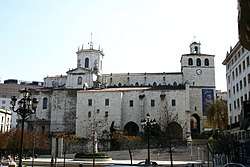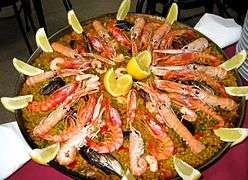Santander, Spain
Santander.jpg)   .jpg)    .jpg) | |||
|---|---|---|---|
| Municipality | |||
| |||
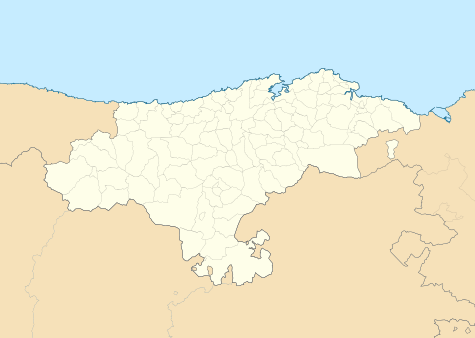 Santander Location of Santander within Cantabria | |||
| Coordinates: 43°27′46″N 3°48′18″W / 43.46278°N 3.80500°WCoordinates: 43°27′46″N 3°48′18″W / 43.46278°N 3.80500°W | |||
| Country |
| ||
| Autonomous community |
| ||
| Province | Cantabria | ||
| Comarca | Bay of Santander | ||
| Judicial district | Santander | ||
| Founded | 26 BC, as Portus Victoriae Iuliobrigensium 9 January 1755, granting the title of city | ||
| Capital | Santander | ||
| Government | |||
| • Alcalde | Gema Igual (2016) (PP) | ||
| Area | |||
| • Total | 35 km2 (14 sq mi) | ||
| Elevation | 15 m (49 ft) | ||
| Highest elevation | 108 m (354 ft) | ||
| Lowest elevation | 0 m (0 ft) | ||
| Population (2013) | |||
| • Total | 178,465 | ||
| • Density | 5,100/km2 (13,000/sq mi) | ||
| Demonym(s) | Santanderino/a, santanderense, pejino/a, chani | ||
| Time zone | UTC+1 (CET) | ||
| • Summer (DST) | UTC+2 (CEST) | ||
| Postal code | 39001-39012 | ||
| Official language(s) | Spanish | ||
| Website | Official website | ||
The port city of Santander (UK: /ˌsæntənˈdɛər,
History
Origins, Roman period and Middle Ages
The origin of the earliest human settlements in the current Santander is not easy to establish because there is little written and archaeological data. However, there would appear to be good practical reasons for ancient settlers to have chosen the north side of the bay, sheltered from it and safer from the storms of the Bay of Biscay, on the north side of the promontory of Somorrostro and along the ancient Becedo estuary. Moreover, the hillside provided good visibility for spotting potential attackers, making this the ideal place for the foundation of a stable settlement, which was to evolve throughout the Middle Ages.[2]
Although it is mentioned for the first time in 1068, in a draft document made by King Sancho II, in the 9th century Alfonso II the Chaste founded the Abbey of the Holy Bodies in the existing chapel on the hill of Somorrostro, housing as holy relics the heads of Saint Emeterius and Saint Celedonius and the graves of other unknown martyrs, giving the abbey its name.[3]

During the 12th and 13th centuries the population was contained within the walls of two different pueblas. La Puebla, the oldest, on the hill overlooking the city facing the bay, included the old castle, the Abbey of the Holy Bodies and the cloister. It had three rows of houses, separated by Rua Carnicerias and Rua Mayor, where the homes of prominent people of the town were, as well as those of the Abbot's canons. Meanwhile, the Puebla Nueva contained the convent of Santa Clara and San Francisco, which gave its name to one of the main streets; other important streets were the Rua de la Sal, The cavalcade Palace, Ribera, Don Gutierre, Puerta de la Sierra, Gallows and the Arcillero Rua. The two pueblas were joined by a bridge over the river that divided Becedo and flowed down to the shipyards, which were ordered by the king to take timber from the Cantabrian forests for shipbuilding. The villa was required to give the monarchy a ship per year.
The city owes its existence to the excellent harbour of the Bay of Santander. Santander was an important port for Castile in the later Middle Ages, and also for trade with the New World. It officially became a city in 1755.[4]
Great fire of 1941
See also (Spanish): Incendio de Santander
Santander fell victim to a great fire[5] in 1941. Fanned by a strong south wind, the fire burned for two days. The fire started in Cádiz Street, next to the harbour, the Cathedral and the medieval quarter.[6] The fire destroyed the Old Town Hall, Jesús de Monasterio and Vargas streets and Atarazanas square buildings. It led to a major change in the architecture of Santander, away from the older small stone and wood buildings with balconies to the enormous blocks of flats built during the reconstruction.
There was only one casualty of the fire, a firefighter from Madrid killed in the line of duty, but thousands of families were left homeless and the city was plunged into chaos. The fire destroyed the greater part of the medieval town centre and gutted the city's Romanesque cathedral.[7]
Climate

The city of Santander has an oceanic climate (Köppen climate classification Cfb), the annual thermal oscillation of the average monthly temperatures reaching around 10°C (18°F).
Humidity is quite high throughout the year and sometimes reaches more than 80%. Average daily maximum temperatures vary from 24 °C (75 °F) in summer down to 13 °C (55 °F) in winter. Summer temperatures are much cooler than in the more southern large cities of Spain, but are typical of the Atlantic coastline. In general however, summers are warmer than further west on the northern coastline. The damp, mild winters are more typical of the mediterranean climate but the frequent precipitation in summer prevents Santander and the northern coast being classified as cool-summer mediterranean, despite having similar temperatures to many such areas. As regards to daytime temperatures, summers in Santander are similar to coastal areas of western France, such as La Rochelle, and coastal areas in the Pacific Northwest, such as Seattle.
The maximum temperature reached in Santander Airport was 37.8 °C (100 °F) on 27 June 2009, and the minimum temperature −5.4 °C (22 °F) on 21 January 1957. The warmest maximum daytime average for a month was in August 2003, with 27.1 °C (80.8 °F).[8] Subtropical months (mean above 22 °C (72 °F)) are however rare. Another weather station recorded 40.2 °C (104 °F) on 17 August 1943.[9]
Sunshine hours are very low by comparison with the rest of mainland and southern Spain. Even compared with other areas of northern Spain, such as Galicia, which have much more sunshine hours in coastal cities such as Vigo or Pontevedra. With just around 1650 hours of sunshine, Santander is about as sunny as London and Paris, and quite a bit less sunny than most of England's south coastal regions.
| Climate data for Santander Airport (1981–2010) Record Temperatures (1954–2016) | |||||||||||||
|---|---|---|---|---|---|---|---|---|---|---|---|---|---|
| Month | Jan | Feb | Mar | Apr | May | Jun | Jul | Aug | Sep | Oct | Nov | Dec | Year |
| Record high °C (°F) | 25.1 (77.2) |
29.0 (84.2) |
31.3 (88.3) |
30.6 (87.1) |
36.8 (98.2) |
37.8 (100) |
37.2 (99) |
37.3 (99.1) |
37.6 (99.7) |
33.5 (92.3) |
28.0 (82.4) |
25.4 (77.7) |
37.8 (100) |
| Average high °C (°F) | 13.6 (56.5) |
13.8 (56.8) |
15.7 (60.3) |
16.6 (61.9) |
19.1 (66.4) |
21.6 (70.9) |
23.6 (74.5) |
24.2 (75.6) |
22.8 (73) |
20.3 (68.5) |
16.3 (61.3) |
14.2 (57.6) |
18.5 (65.3) |
| Daily mean °C (°F) | 9.7 (49.5) |
9.8 (49.6) |
11.3 (52.3) |
12.4 (54.3) |
15.1 (59.2) |
17.8 (64) |
19.8 (67.6) |
20.3 (68.5) |
18.6 (65.5) |
16.1 (61) |
12.5 (54.5) |
10.5 (50.9) |
14.5 (58.1) |
| Average low °C (°F) | 5.8 (42.4) |
5.7 (42.3) |
7.0 (44.6) |
8.3 (46.9) |
11.1 (52) |
13.9 (57) |
16.0 (60.8) |
16.4 (61.5) |
14.4 (57.9) |
11.8 (53.2) |
8.7 (47.7) |
6.7 (44.1) |
10.5 (50.9) |
| Record low °C (°F) | −5.4 (22.3) |
−5.2 (22.6) |
−3.0 (26.6) |
0.6 (33.1) |
2.6 (36.7) |
5.6 (42.1) |
6.0 (42.8) |
6.0 (42.8) |
2.8 (37) |
1.4 (34.5) |
−3.5 (25.7) |
−5.2 (22.6) |
−5.4 (22.3) |
| Average precipitation mm (inches) | 106 (4.17) |
92 (3.62) |
88 (3.46) |
102 (4.02) |
78 (3.07) |
58 (2.28) |
52 (2.05) |
73 (2.87) |
83 (3.27) |
120 (4.72) |
157 (6.18) |
118 (4.65) |
1,129 (44.45) |
| Average precipitation days (≥ 1 mm) | 12 | 11 | 10 | 12 | 10 | 8 | 7 | 8 | 9 | 11 | 13 | 12 | 124 |
| Average relative humidity (%) | 72 | 72 | 71 | 72 | 74 | 75 | 75 | 76 | 76 | 75 | 75 | 73 | 74 |
| Mean monthly sunshine hours | 85 | 104 | 135 | 149 | 172 | 178 | 187 | 180 | 160 | 129 | 93 | 74 | 1,649 |
| Source: Agencia Estatal de Meteorología[10] | |||||||||||||
Tourism
The bars and restaurants of the old town are popular with tourists, as well as the El Sardinero beach a couple of kilometres away.[11]
Politics and government
The PP were the leading party in the municipal elections of 1999, 2003 and 2007.[12]
Economy
As a service centre at the regional level, Santander contains important public institutions and private organisations with a large number of employees, including Marqués de Valdecilla University Hospital, the University of Cantabria and Grupo Santander. Activities related to culture, leisure and tourism are an important part of the city's economy, and the regional and municipal authorities look to augment the summer tourist trade with additional offerings, including conventions, conferences, cultural festivals and cruises. Banco Santander, Spain's largest bank and corporation, is headquartered here.
The city
Main sights

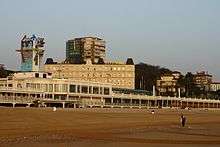
- The Cathedral of Santander:[13]
- The lower temple, called "cripta del Cristo" was built around 1200 on other earlier Roman buildings. It is 31 meters long and 18 wide, organised into three naves. Its style is a transition from romanesque to gothic and is accessed by two doors of late romanesque. Here the remains of the Holy Martyrs (Emeterius and Celedonius) are kept, which reached Portus Victoriae (the ancient Roman Santander) by boat.
- The upper church was built between the late 13th and 14th century. After it was completed the gothic cloister was built.
- El Sardinero was in 1840 a rugged area of Santander environment.[14]
- The Palacio de la Magdalena, eclectic style, English influenced, built in 1909 by public subscription as a gift for the Spanish Royal Family.[15]
- El Hotel Real was opened in the summer of 1917, in a privileged location overlooking the bay and the open sea. It is a five-story building, with south porch on a high terrace. The style is modern with an air of eclecticism, by the architect González Riancho.[16]
- The Gran Casino del Sardinero completed in 1916, has some relationship to El Hotel Real and is one of the symbols of the city. It has a terrace balcony which is accessed by a monumental staircase. The two-story central body is framed at the sides with two octagonal towers, covered by domes, whose edges involved, from top to bottom, shafts with capitals for each floor.[17]
- The Lighthouse of Cabo Mayor presides over the entrance to the Bay of Santander.[18]
Streets, avenues and boulevards
- Paseo de Pereda (The ancient pier is a promenade overlooking the bay and the towns of Somo and Pedreña. cafés can be found as old as "El Suizo" where, in the past, traders and military writers met, such as Pereda himself). The Gardens also have the same name (which, in turn, is the monument to the writer José María de Pereda, which contains references to his works).
- Reina Victoria Avenue (location of chalets overlooking the bay. Through this street is access to the beach Los Peligros).
- Paseo del General Dávila (El Alta) (former Meteorological Observatory of Santander, I.E.S. José María de Pereda, Conservatorio Jesús de Monasterio).
- Paseo de Pérez Galdós.
- Castelar Street. (Overlooking the bay, joins the Paseo de Pereda with Reina Victoria Avenue)
- Calvo Sotelo Street (Ministry of Finance, Post).
- Burgos Street (It is one of the oldest streets of the city. It may be considered part of the old part of town, although the first references to the street date from the mid-18th century. The title of Burgos Street was awarded in 1845. The pedestrian-only street has benefited the trade of the area and its residents. This street is the headquarters of the ONCE and the Plaza de Juan Carlos I).
- San Fernando Street (Street with great traffic flow is the main gateway to the city center. The Plaza de las Cervezas is a pedestrian-only area which belongs to this street, named for the brewery (La Cruz Blanca) which stood there before its current disposition.)
- Alameda de Oviedo (Paseo full of trees, runs from the streets of San Fernando and Vargas, parallel to them, between Cuatro Caminos and Numancia).
- Avenida de los Castros (In this broad avenue are located most of the universities centres of the University of Cantabria)
Parks and gardens

- Park of la Magdalena (Located on the Magdalena Peninsula, it is a major tourist spot thanks to the Palacio de la Magdalena, the tank seals and the old stables of the palace, where different college classes at UIMP are held.)
- Las Llamas Atlantic Park (Open to the public on 11 May 2007, but today is still under construction. The park was initially budgeted at 22.5 million euros, but its price has risen 39.1% (8.8 million euros) for the incorporation of improvements).[19]
- Piquío Gardens (so called because they are shaped like the beak of a ship that "enters" into the sea, referring to the views offered at the end of the garden).
- La Marga Park (located on the outskirts of the city, at the end of Castilla Street, named for the old timber that was placed there.)
Squares
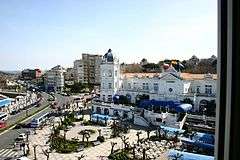

- Plaza del Ayuntamiento (City Council Square).
- Plaza de Pedro Velarde (Pedro Velarde Square) or Plaza Porticada.
- Plaza de Pombo (Pombo Square)
- Plaza de Atarazanas (Shipyards Square) or Plaza de la Catedral.
Smart city
Santander is pilot for a Smart city. It is embedded with 12,000 sensors.[20][21]
Education
- University of Cantabria is the largest university in Cantabria.
- European University of the Atlantic is a private university founded in 2013.
- Universidad Internacional Menéndez Pelayo (UIMP) specializes in teaching Spanish language and culture to foreign students.
Culture
Santander has a great tradition and cultural activity, with events that play an important role in cultural and social life of the city. UIMP is a major international summer university and organizes large festivals of music and dance. The Festival Internacional de Santander (FIS), Festival Internacional de Música de Órgano (FiMÓC), Encuentro de Música y Academia and the Paloma O'Shea International Piano Competition are main cultural events.
Festivals
Santander is a city of many festivals and pilgrimages, distributed across the various neighborhoods and areas of the city. Worthy of mention is the existence of many feasts of neighborhood character, such as those of Mendicoague, Perines, etc. The best known festivals in Santander and more tourist attraction, are:
- January 5: The Cavalcade of Magi covers a small part of the city, from the Palacio de Festivales to the Plaza del Ayuntamiento.
- The first Sunday of June: Cantabria Child Day is celebrated on Magdalena. It is a 'Regional Tourist Interest', an exaltation of the native, organized by the "Association for the Defence of the Interests of Cantabria" (ADIC), an association founded by Miguel Ángel Revilla. In this event are shown, among other things, an exhibition of "Aluche" (Ancient Cantabrian Fighting) and types of rural sports like milkmaid racing, archery, salto pasiego and wood chopping.
- Monday of Pentecost: Fiestas de la Virgen del Mar.
- June 24: The Bonfires of Saint John is celebrated in El Sardinero, particularly in the second beach of Sardinero. This festival celebrates the arrival of summer with a bonfire and a pilgrimage. In other parts of the municipality bonfires are also made, as in la Albericia and the Barrio Pesquero neighborhoods.
- July 25: Festivals of Saint James (Regional Tourist Interest).
- August 30: Feasts of the Holy Martyrs (Emeterius and Celedonius). Santander patrons.
- September 15: Fiestas de la Virgen de la Bien Aparecida, patroness of the Diocese of Santander and Cantabria ('Regional Tourist Interest'.)
Diet
Santander's cuisine is characteristic of Cantabria in that it is based mainly on seafood. Popular shellfish include almejas (clams) and navajas (razor clams); fish include seabream, red mullet, anchovies, seabass and sardines; and squid and cuttlefish are also commonly eaten.
Some typical dishes from the city of Santander are the fried calamari called rabas, double donuts, bean stew called cocido montañés, and seafood dishes ranging from seabass and sardine to products such as morguera.
Some of the popular locations to get food in the city include the Barrio Pesquero, Puertochico, El Sardinero, and Corbán.
Famous people
Historical Figures
- Francisco Marroquin (1499–1563) the first bishop of Guatemala and provisional Governor of Guatemala
- Toribio de Peñalva (c.1606-c.1685) a Spanish military man, who served during the Viceroyalty of Peru as Alcalde de la Hermandad and Procurator General of Buenos Aires
- Manuel Pardo (1774–?) a Spanish soldier who was the Interim Governor of Spanish Texas in 1817
- José de Madrazo y Agudo (1781–1859) a Spanish painter and engraver, an exponent of the Neoclassical style in Spain
19th Century
- Jenaro Quesada, 1st Marquis of Miravalles (1818–1889) Grandee of Spain and Spanish soldier
- José Antonio Mijares (1819–1847) a Mexican Army Lieutenant who led the Mexican resistance force against the American garrison of San José del Cabo in the Battle of San José del Cabo
- Rafael Izquierdo y Gutiérrez (1820–1883) a Spanish Military Officer, politician, and statesman; Governor-General of the Philippines from 1871 to 1873
- Marcelino Sanz de Sautuola (1831-1888) a Spanish jurist, amateur archaeologist, owned the land of the Cave of Altamira
- Marcelino Menéndez y Pelayo (1856–1912) a Spanish scholar, historian and literary critic.
- Francisco Iturrino (1864–1924) a Spanish Post-impressionist painter of Basque ancestry, sometimes called a Fauvist
- Concha Espina (c.1877-1955) a Spanish writer nominated for a Nobel prize in literature 25 times in nine years
- Marcial Solana González-Camino (1880–1958) a Spanish scholar, writer and politician; historian of philosophy
- María Gutiérrez Blanchard (1881–1932) a Spanish painter, developed a unique style of Cubism
- Ángel Herrera Oria (1886–1968) a Spanish journalist, Roman Catholic politician and later a cardinal
- Gerardo Diego (1896–1987) a Spanish poet, a member of the Generation of '27
20th Century
- Emilio Botín (1903–1993) a Spanish banker, the chairman of Santander Group from 1950 to 1986
- José Luis Zamanillo (1903–1980) was a Spanish Traditionalist politician and leader of Carlist paramilitary Requeté structures
- Francisco de Borbón y Borbón (1912-1995) a Spanish aristocrat, Lieutenant General of the cavalry in the Spanish army
- Matilde Camus (1919–2012) a Spanish poet who also wrote non-fiction
- Eulalio Ferrer (1921-2009) a Spanish-Mexican entrepreneur, involved in communications and advertising
- Elena Quiroga (1921–1995) Spanish writer, explored the themes of childhood and adolescence
- Daniel Gil (1930–2004) one of the leading Spanish graphic designers of the 20th century
- Vital Alsar (born 1933) maritime explorer
- Emilio Botín (1934-2014) a Spanish banker, executive chairman of Spain's Grupo Santander
- Juan Carlos Calderon (1938–2012) a Spanish singer-songwriter and musician
- Álvaro Pombo (born 1939) a Spanish poet, novelist and activist
- Juan Navarro Baldeweg (born 1939) a Spanish architect and professor at the Superior Technical School of Architecture of Madrid
- Alfonso Vallejo (born 1943) a Spanish playwright, poet, painter and neurologist, he has published 34 plays and 25 poetry books.
- Germán Gullón (born 1945) literary critic, writer and professor of Spanish literature at the University of Amsterdam
- Domingo Sarrey (born 1948) a visual artist and video artist.
- José Antonio Rodríguez Vega (1957–2002) nicknamed El Mataviejas (The Old Lady Killer), was a Spanish serial killer who raped and killed at least 16 elderly women in and around Santander between August 1987 and April 1988
- Ana Patricia Botín DBE (born 1960) a Spanish banker, she was appointed executive chairman of Santander Group in 2014
- Jaime Martín (born 1965) a Spanish orchestral conductor, previously a flautist, he has lived in London since 1992
- Álvaro Longoria (born 1968) a film director, executive producer and actor
- Eduardo Noriega (born 1973) actor
Athletes
- Marcos Alonso Imaz (1933–2012) nicknamed Marquitos, was a Spanish footballer, 272 pro appearances
- José Pérez Francés (born 1936) a Spanish former professional road racing cyclist
- Francisco Javier Aguilar Garcia (born 1949) a Spanish retired professional footballer 300 pro appearances
- Seve Ballesteros (1957–2011) a Spanish professional golfer and World No. 1
- Quique Setién (born 1958) a Spanish retired footballer, 518 pro appearances, current coach of Real Betis
- Marcos Alonso Peña (born 1959) a Spanish retired footballer, and a current coach, 309 pro appearances
- José Ignacio Bollaín Ochoa (born 1974) known as Iñaki, is a retired Spanish footballer, over 500 pro appearances
- Iván Helguera (born 1975) a Spanish football player, 326 pro appearances
- Pedro Munitis (born 1975) a Spanish football player, 475 pro appearances
- Iván de la Peña (born 1976) a Spanish football player, 331 pro appearances
- Mario Bermejo (born 1978) a Spanish retired professional footballer, 546 pro appearances
- Ruth Beitia (born 1979), high jumper, gold medallist at the 2016 Olympic Games
- Gonzalo Colsa (born 1979) a Spanish retired footballer 394 pro appearances
- Fernando San Emeterio (born 1984) a Spanish professional basketball player
- Beatriz Fernandez (born 1985) a Spanish handball player
- Berta Betanzos (born 1988) a Spanish sports sailor, competed in the 2012 and the 2016 Summer Olympics
- Sergio Canales (born 1991) a Spanish football player
Sports
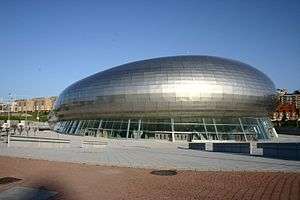
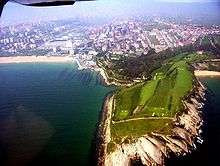
In this city Racing de Santander, one of the historic and certainly that was one of the founders of La Liga, play their home games at the Campos de Sport de El Sardinero. Racing de Santander has been 40 seasons in first division and 32 in second. In the 1930/1931 season, it finished second level on points with Athletic Club Bilbao (champion) and the Real Sociedad (third), that time was the one that came closest to winning the league championship.
A long tradition in the city was handball, with CB Cantabria as a banner that has taken the name of Santander in Europe and the world with the achievement of several international titles, the European Cup in 1994,the Recopa in 1990 and 1998 and the EHF Cup in 1993. Currently, the club is dissolved. The only team that has an important place in the national scene at the moment is the Adelma Santander 2016, belonging to the Handball Club Sinfín. It competes in the category of the División de Honor Plata (second division).
Some elite teams of Santander:
| Club | Sport | Ligue | Stadium |
|---|---|---|---|
| Racing de Santander | Football | Segunda División B | Campos de Sport de El Sardinero |
| GoFit Sinfín | Handball | Liga ASOBAL | Pabellón Municipal de La Albericia |
| Cantbasket and CD Estela | Basketball | Liga EBA | Palacio de Deportes de Santander |
| Balonmano Pereda | Women's handball | División de Honor B | Pabellón de Numancia |
| Real Sociedad de Tenis de La Magdalena | Field hockey | Honour Division | La Albericia |
| Señor Independiente | Rugby Union | Honour Division | Mies de Cozada |
Panoramic view
See also
References
- ↑ Jones, Daniel (2003) [1917], Peter Roach, James Hartmann and Jane Setter, eds., English Pronouncing Dictionary, Cambridge: Cambridge University Press, ISBN 3-12-539683-2
- ↑ Fernández González, Lorena (2002). Santander una ciudad Medieval. Estvdio. ISBN 9788495742056.
- ↑ "Catholic Encyclopedia: Santander". Newadvent.org. 1 February 1912. Retrieved 14 April 2011.
- ↑ Ringrose, David R. (2005). Toward a contemporary city: Santander, 1755-1910. Ed. Universidad de Cantabria. p. 7. ISBN 9788481029772.
- ↑ Aupí, Vicente (2005). El Incendio de 1941 en Santander. Guía del Clima en España. Omega. p. 75. Consultado el 16 de mayo de 2013. ISBN 84-282-1370-4
- ↑ "Así ocurrió", El Diario Montañés (in Spanish), 12 February 2011, retrieved 14 December 2014
- ↑ "Balance de la tragedia", El Diario Montañés (in Spanish), 13 February 2011, retrieved 14 December 2014
- ↑ "Extreme values for Santander". Aemet.es. Retrieved 22 July 2015.
- ↑ "Extreme values for Santander, Ciudad". Aemet.es. Retrieved 22 July 2015.
- ↑ "Valores Climatológicos Normales. Santander / Aeropuerto". July 2011.
- ↑ "Santander". Spain: Cantabria and Asturias. Rough Guides. Retrieved 24 December 2015.
- ↑ "Resultados municipales: Santander". El Pais. PRISA. Archived from the original on 28 May 2007. Retrieved 8 January 2018.
- ↑ David de la Garma. "Catedral de Santander" (in Spanish). Arteguias.com. Retrieved 14 April 2011.
- ↑ "City of Santander". Cantabriajoven.com. Archived from the original on 2 January 2011. Retrieved 14 April 2011.
- ↑ "Palace of La Magdalena, History".
- ↑ "History Eurostars Hotel Real". Retrieved 2014-12-15.
- ↑ "Gran Casino Sardinero". Retrieved 2014-12-15.
- ↑ "Lighthouse of Cabo Mayor". Puertosantander.es. Retrieved 14 April 2011.
- ↑ J. F. R./Santander (1 December 1997). "El Parque de Las Llamas quedará abierto al público el próximo viernes". Eldiariomontanes.es. Retrieved 14 April 2011.
- ↑ Santander: The Smartest Smart City. Governing, May 2014
- ↑ SmartSantander Website
Bibliography
- See also: Bibliography of the history of Santander
External links
| Wikimedia Commons has media related to Santander. |
| Wikivoyage has a travel guide for Santander. |
- Official tourism website
- Webcams de Santander y Cantabria — Live webcams Santander and Cantabria.
- Ayuntamiento de Santander — Official website of the Santander City Council (In Spanish).
- Webcam en Puertochico — Live webcam of Santander's Puertochico district.
- Tiempo y webcam de Santander desde El Sardinero — Live webcam and weather station at Sardinero beach

.svg.png)
